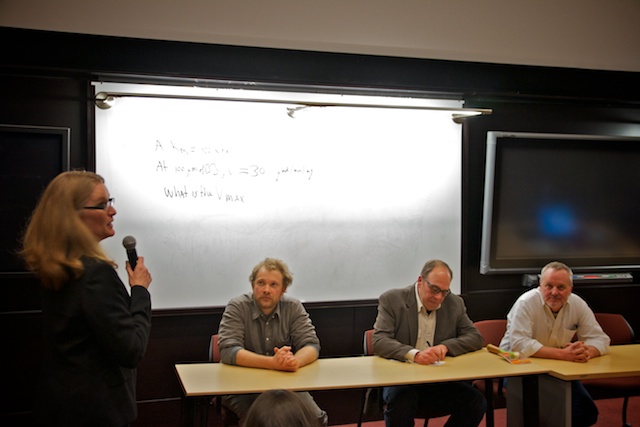We landed in DIA and promptly got stuck in an hour long line for the car rental, which made us late for our first screening in Colorado, at Eaton High School FFA.
Chris Ely, co-founder of Applegate, our friend and veteran companion on the road the past year, got there before us and gave an intro to the documentary before Heidi Lanning, the kind FFA AgEd instructor hit play on the DVD player. We got there with a few minutes to spare, and we stopped the film after the second section finished.
Chris and I talked to the 11 students about the advantages and disadvantages of different agricultural systems. Many of the students were farmers, who work on other people's farms, growing feed, or working in the trucking of feed, or the raising of animals.
We thanked Heidi and drove to Ft. Collins where we got food at Cooper Smith's, a local brewery with great food.
There was a swarm of students outside the auditorium, as the first 100 people in attendance got free burritos. A few probably got the burritos without attending the documentary, something I may well have done in college. Ryan, of the Campus Environmental Center, did a great job setting up the screening and getting the word out.
About 150 filled into the state-of-the-art auditorium, which was very vertically steep, a design feature that seems to make larger venues a bit more personal because the seats in the back aren't as far away.

We were especially thrilled that a young farmer named Sheldon actually brought dozens of eggs to sell at the screening, something we hope to do much more of at screenings in the future.
The discussion afterwards was a good one, passion in the crowd expected at one of the top agricultural schools in America. We were lucky to have the conversation moderated by Kim, who's the food editor at the Food Editor at the Denver Post.
Someone asked about why Chuck Wirtz didn't direct market, and we explained that he has such a huge amount of pork to move, 330 pigs a week, and is not close enough to a major metropolitan area to sell that much pork directly.
One woman talked about how the film didn't talk about science, and about how she trusted the meat in the grocery store, and that the slaughter facility at Polyface looked unsanitary. I responded by saying that the anonymous nature of the sourcing to grocery stores has recently led to the horse meat mishap, and that meat from a local farmer is safer because there is a single animal that sources one package of ground beef, whereas in the grocery store or at a McDonald's one hamburger can be from hundreds of different animals, therefore, increasing the risk that one of them is contaminated. The comment was too charged with emotion, and thus provoked a strong response from some of the students in attendance. One young woman, in the meat science department came down and talked about the importance of science when making decisions about what type of agriculture to support. She, too, was charged with emotion, because agriculture is about as important a topic that we can discuss.

A poultry processor talked about how he lost his USDA slaughter facility recently, which has made it very hard for Colorado chicken farmers to slaughter and sell directly to customers. Everyone agreed that we need to change our regulations so that they fit the size of the producer. Currently, many regulations are written for large slaughter facilities, and then these regulations, and the accompanying paperwork are foisted onto the small meat lockers that don't have the same amount of time and people to fill everything out.
Do you like this post?